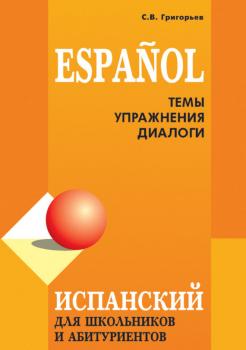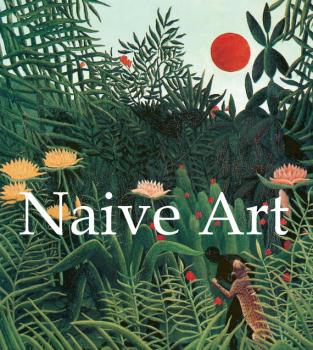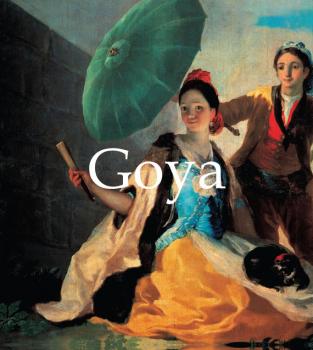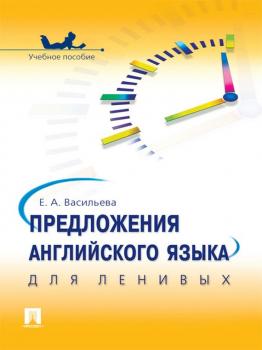Иностранные языки
Различные книги в жанре Иностранные языкиИспанский язык для школьников и абитуриентов: темы, упражнения, диалоги
Данный сборник предназначен для абитуриентов, учащихся средних образовательных школ и школ с углубленным изучением испанского языка, людей, занимающихся испанским языком на курсах и самостоятельно, а также для всех тех, кто интересуется языком и культурой Испании. Кроме того, он может быть с успехом использован студентами младших курсов в процессе подготовки устных тем на занятиях по разговорной практике и страноведению.
Грамматика испанского языка. Сборник упражнений
Предлагаемый сборник содержит упражнения по основным темам грамматики испанского языка для неполной средней школы. В нем рассматриваются знаменательные и служебные части речи, различные наклонения глаголов, а также ударение. В приложении приводится таблица спряжения неправильных глаголов. Сборник предназначен для учащихся средних школ независимо от их профиля, а также может быть использован при работе со взрослыми в пределах программы элементарного уровня изучения испанского языка.
Alphabet of the Human Mind. Psychology flagship
AHM is not only a science but also a combat art for the MIND, which You can be mastered. More accurate and complete Classification of Personality Types simply does not exist! Each concept from AHM such important as the gear from mechanism of Swiss watches. Become a Professional Psychologist, reading one Book? Thanks to the heroic work of the Authors of AHM this possible today! “If life has attached instruction, it would be called – Alphabet of the Human Mind!” ©
Naive Art
Until the end of the 19th century Naïve Art, created by untrained artists and characterised by spontaneity and simplicity, enjoyed little recognition from professional artists and art critics. Naïve painting is often distinguished by its clarity of line, vivacity and joyful colours, as well as by its rather clean-cut, simple shapes, as represented by French artists such as Henri Rousseau, Séraphine de Senlis, André Bauchant and Camille Bombois. However, this movement has also found adherents elsewhere, including Joan Miró (who was influenced by some of its qualities), Guido Vedovato, Niko Pirosmani, and Ivan Generalic.
Lempicka
The smoothly metallic portraits, nudes and still lifes of Tamara de Lempicka encapsulate the spirit of Art Deco and the Jazz Age, and reflect the elegant and hedonistic life-style of a wealthy, glamorous and privileged elite in Paris between the two World Wars. Combining a formidable classical technique with elements borrowed from Cubism, Lempicka’s art represented the ultimate in fashionable modernity while looking back for inspiration to such master portraitists as Ingres and Bronzino. This book celebrates the sleek and streamlined beauty of her best work in the 1920s and 30s. It traces the extraordinary life story of this talented and glamorous woman from turn of the century Poland and Tsarist Russia, through to her glorious years in Paris and the long years of decline and neglect in America, until her triumphant rediscovery in the 1970s when her portraits gained iconic status and world-wide popularity.
Kirchner
The self-appointed “leader” of the artists’ group Die Brücke (Bridge), founded in Dresden in 1905, Ernst Ludwig Kirchner was a key figure in the early development of German Expressionism. His first works show the influence of Impressionism, Post-impressionism and Jugendstil, but by about 1909, Kirchner was painting in a distinctive, expressive manner with bold, loose brushwork, vibrant and non-naturalistic colours and heightened gestures. He worked in the studio from sketches made very rapidly from life, often from moving figures, from scenes of life out in the city or from the Die Brücke group’s trips to the countryside. A little later he began making roughly-hewn sculptures from single blocks of wood. Around the time of his move to Berlin, in 1912, Kirchner’s style in both painting and his prolific graphic works became more angular, characterized by jagged lines, slender, attenuated forms and often, a greater sense of nervousness. These features can be seen to most powerful effect in his Berlin street scenes. With the outbreak of the First World War, Kirchner became physically weak and prone to anxiety. Conscripted, he was deeply traumatised by his brief experience of military training during the First World War. From 1917 until his death by suicide in 1938, he lived a reclusive, though artistically productive life in the tranquillity of the Swiss Alps, near Davos.
Goya
Goya is perhaps the most approachable of painters. His art, like his life, is an open book. He concealed nothing from his contemporaries, and offered his art to them with the same frankness. The entrance to his world is not barricaded with technical difficulties. He proved that if a man has the capacity to live and multiply his experiences, to fight and work, he can produce great art without classical decorum and traditional respectability. He was born in 1746, in Fuendetodos, a small mountain village of a hundred inhabitants. As a child he worked in the fields with his two brothers and his sister until his talent for drawing put an end to his misery. At fourteen, supported by a wealthy patron, he went to Saragossa to study with a court painter and later, when he was nineteen, on to Madrid. Up to his thirty-seventh year, if we leave out of account the tapestry cartoons of unheralded decorative quality and five small pictures, Goya painted nothing of any significance, but once in control of his refractory powers, he produced masterpieces with the speed of Rubens. His court appointment was followed by a decade of incessant activity – years of painting and scandal, with intervals of bad health. Goya’s etchings demonstrate a draughtsmanship of the first rank. In paint, like Velázquez, he is more or less dependent on the model, but not in the detached fashion of the expert in still-life. If a woman was ugly, he made her a despicable horror; if she was alluring, he dramatised her charm. He preferred to finish his portraits at one sitting and was a tyrant with his models. Like Velázquez, he concentrated on faces, but he drew his heads cunningly, and constructed them out of tones of transparent greys. Monstrous forms inhabit his black-and-white world: these are his most profoundly deliberated productions. His fantastic figures, as he called them, fill us with a sense of ignoble joy, aggravate our devilish instincts and delight us with the uncharitable ecstasies of destruction. His genius attained its highest point in his etchings on the horrors of war. When placed beside the work of Goya, other pictures of war pale into sentimental studies of cruelty. He avoided the scattered action of the battlefield, and confined himself to isolated scenes of butchery. Nowhere else did he display such mastery of form and movement, such dramatic gestures and appalling effects of light and darkness. In all directions Goya renewed and innovated.
Bosch
Hieronymus Bosch was painting frightening, yet vaguely likable monsters long before computer games were ever invented, often including a touch of humour. His works are assertive statements about the mental illness that befalls any man who abandons the teachings of Christ. With a life that spanned from 1450 to 1516, Bosch experienced the drama of the highly charged Renaissance and its wars of religion. Medieval tradition and values were crumbling, paving the way to thrust man into a new universe where faith lost some of its power and much of its magic. Bosch set out to warn doubters of the perils awaiting any and all who lost their faith in God. His favourite allegories were heaven, hell, and lust. He believed that everyone had to choose between one of two options: heaven or hell. Bosch brilliantly exploited the symbolism of a wide range of fruits and plants to lend sexual overtones to his themes, which author Virginia Pitts Rembert meticulously deciphers to provide readers with new insight into this fascinating artist and his works.
Предложения английского языка для ленивых
Вы хотите быстро выучить основные грамматические правила английского языка? Без труда разобраться в построении английских предложений, в классификации и характеристиках всех типов предложения? Тогда эта книга для вас! С ее помощью вы сможете усвоить или закрепить необходимые вам знания. Книга предназначена для школьников, студентов, а также всех желающих самостоятельно изучать английский язык.
Правила чтения английских слов для ленивых. Учебное пособие
Цель пособия – познакомить с правилами чтения односложных, двусложных и многосложных слов английского языка, что в дальнейшем поможет выработать и закрепить навыки быстрого правильного чтения слов данных групп при минимальном использовании транскрипции. Материал в пособии изложен в виде таблиц и моделей. Это поможет вам с легкостью усвоить правила чтения английских слов. Для всех интересующихся английским языком.









